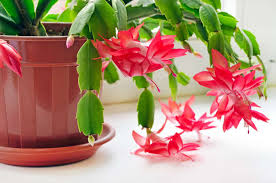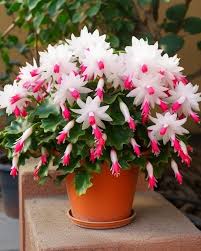By Jessica Jacobs, Contributing Writer
The Christmas cactus (Schlumbergera spp.) is a festive favorite, cherished for its vibrant blooms that brighten homes during the holiday season. With proper care, this remarkable plant can thrive year-round, offering lush foliage and repeat blooms. Whether you’re a seasoned plant parent or a beginner, this guide provides everything you need to cultivate and maintain a healthy Christmas cactus in a pot.
Choosing the Right Pot
Selecting the right container is essential for optimal growth. Use a pot with drainage holes to prevent water from accumulating and causing root rot. Materials like plastic, clay, or ceramic work well, as they retain moisture without becoming overly saturated.
Preparing the Perfect Potting Mix
Christmas cacti require a well-draining, slightly acidic soil with a pH of 5.5 to 6.5. A mix of peat moss, perlite, and sand is ideal. When planting, avoid burying the roots too deeply—these plants prefer shallow placement, allowing ample room for root expansion.
Light and Temperature Requirements
Position your Christmas cactus in a spot with bright, indirect light, such as near a north or east-facing window. Avoid direct sunlight, which can scorch the leaves. Maintain temperatures between 60°F and 70°F (15°C-21°C). To encourage bud formation, expose the plant to cooler temperatures around 50°F (10°C) for a few weeks in the fall.
Watering and Humidity
Water the plant thoroughly when the top inch of the soil feels dry. Let excess water drain to prevent root rot. During blooming, increase humidity by misting the plant or placing it near a water-filled tray. Proper hydration promotes vibrant flowers and healthy growth.
Fertilizing for Success
Feed your Christmas cactus every two to four weeks during the active growing season (spring and summer) with a balanced houseplant fertilizer diluted to half strength. Avoid fertilizing during the dormant phase in fall and winter, as the plant’s nutrient needs decrease.
Pruning and General Maintenance
Prune your Christmas cactus after it finishes blooming. This encourages fuller, bushier growth and helps maintain an attractive shape. Remove any dead or damaged segments and consider propagating these cuttings to grow new plants. Wipe the leaves gently with a damp cloth to keep them clean and free of dust.

Encouraging Dormancy and Blooming
A dormancy period is crucial for the Christmas cactus to bloom again. In the fall, reduce watering and place the plant in a cool (50°F-55°F or 10°C-13°C), dim area for about six weeks. Gradually reintroduce light and regular care after dormancy, and watch your plant reward you with beautiful flowers.
Pest Control
Common pests such as mealybugs and spider mites can affect Christmas cacti. Inspect your plant regularly for signs of infestation, like webbing or white cotton-like spots. Treat infestations promptly with insecticidal soap or neem oil to prevent damage.
By following these guidelines, your Christmas cactus will flourish, providing year-round greenery and seasonal blooms that captivate and delight. With a bit of care and attention, this timeless plant will become a centerpiece of your indoor garden.
Let me know if you’d like further adjustments!
